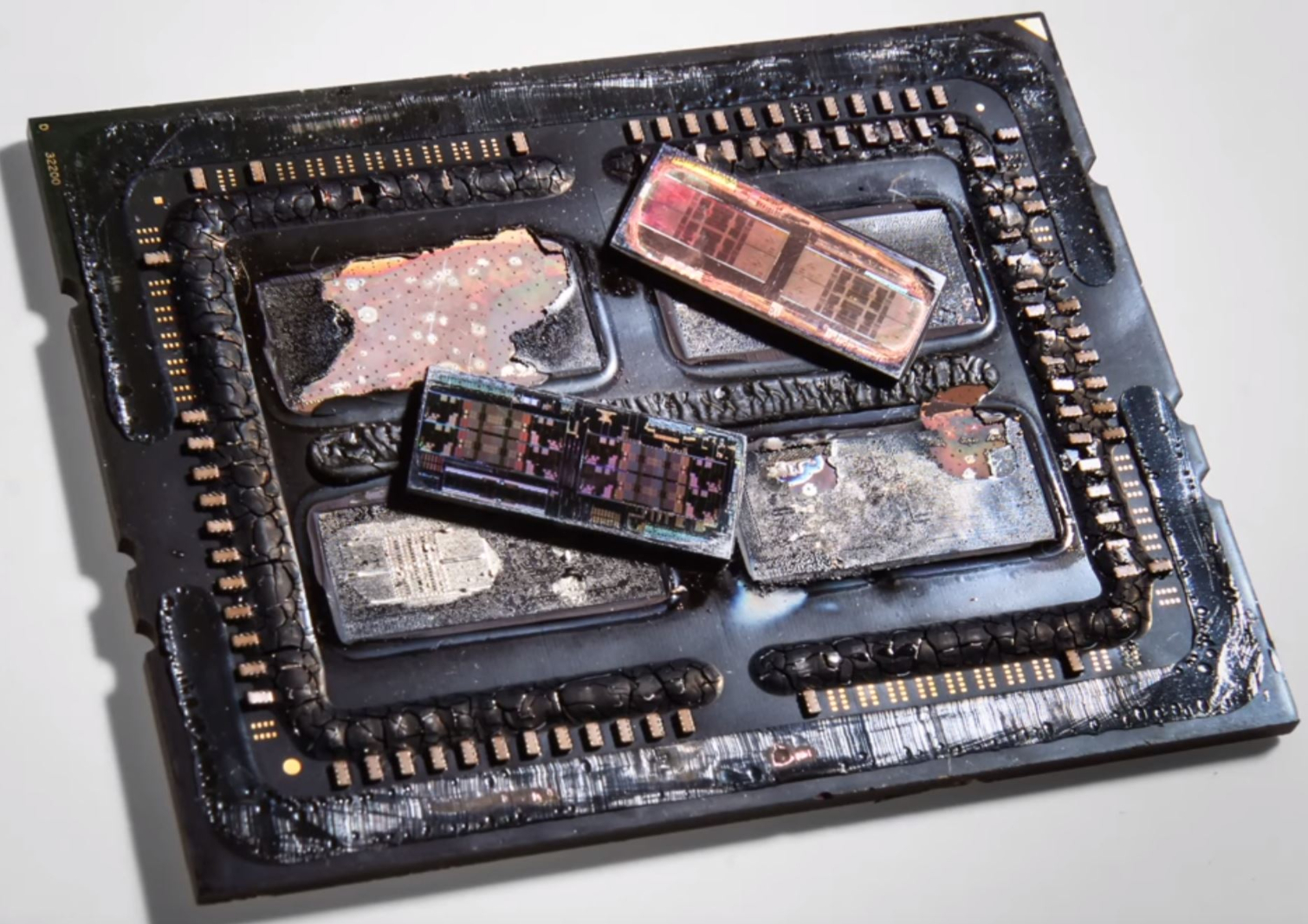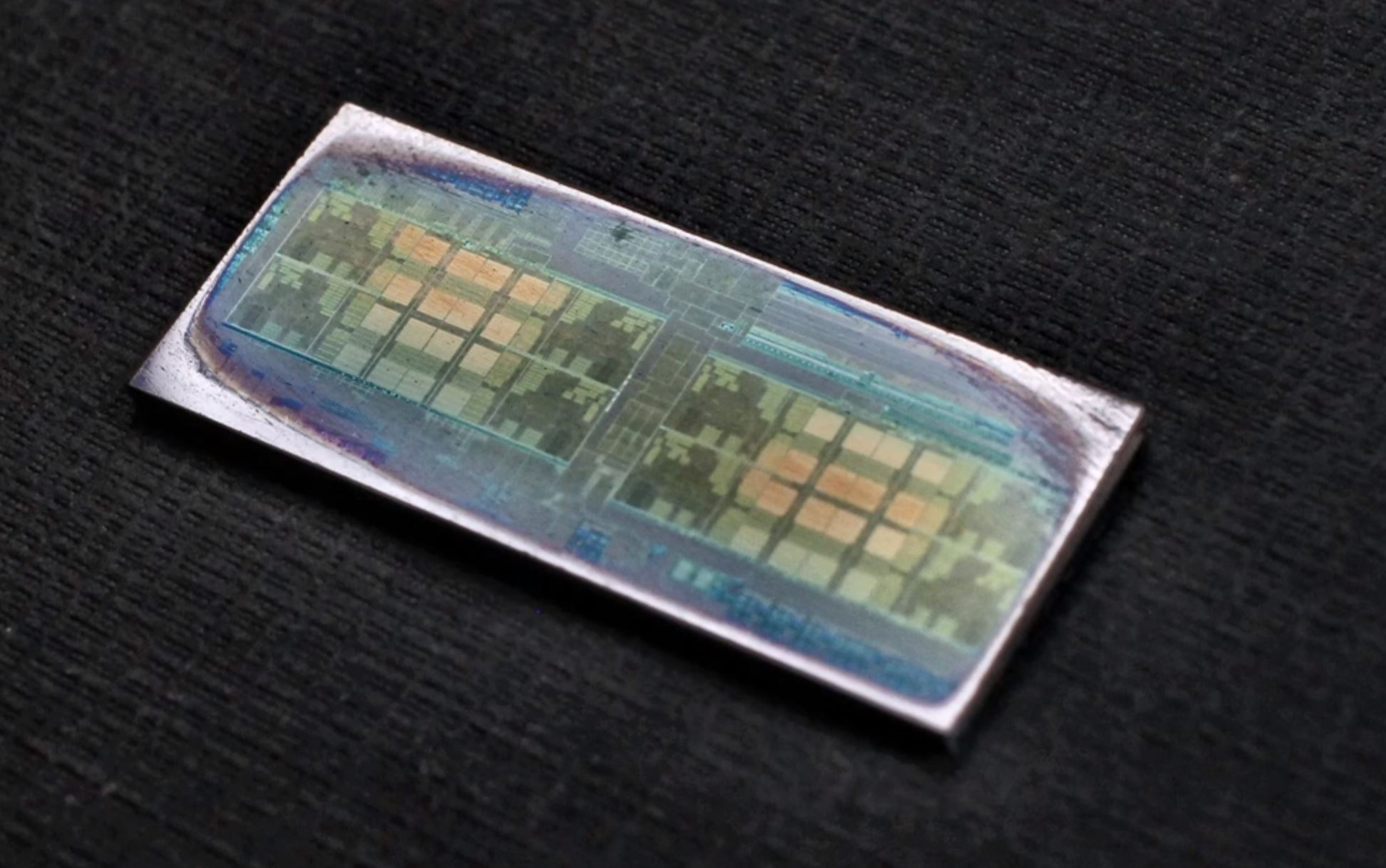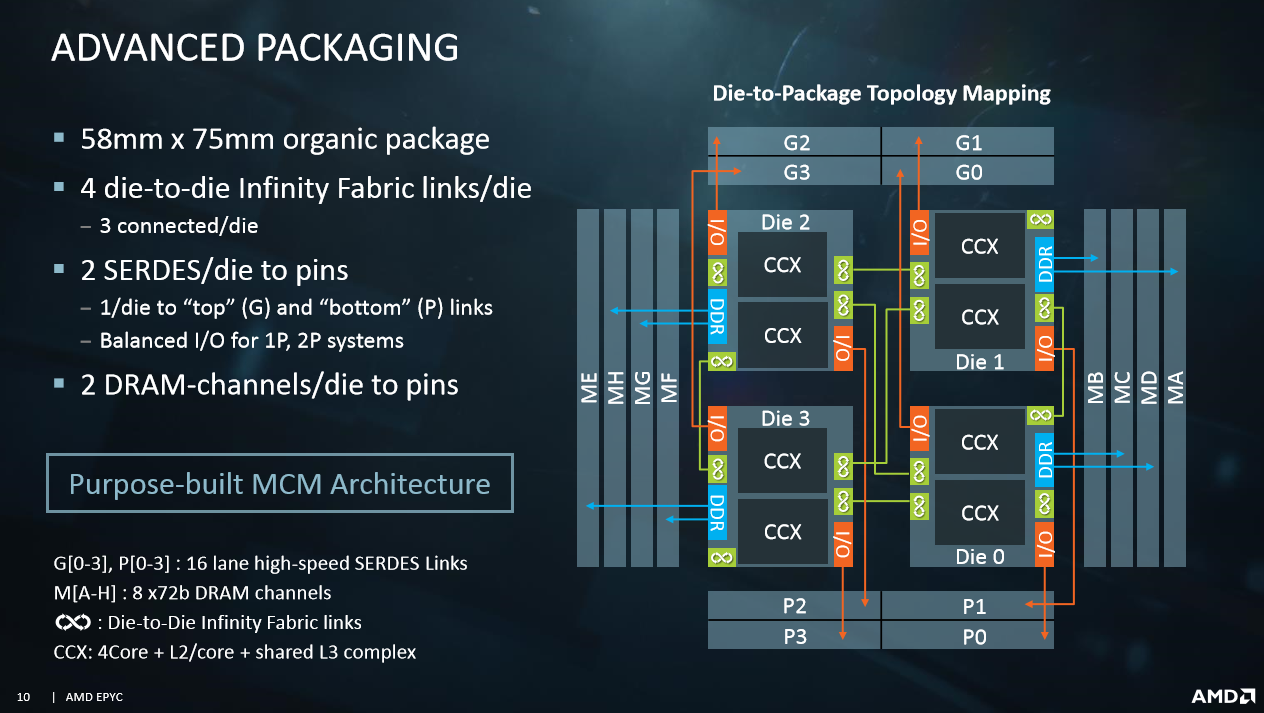Retail AMD Threadripper Delidded, Four Die Present
Der8auer purchased a retail Threadripper 1950X and found what appears to be four active Zeppelin die soldered to the IHS. We followed up with AMD for more detail.
Earlier this year, Der8auer delidded a Threadripper engineering sample and found that the processors still feature all four Zeppelin die, similar to AMD's EPYC data center processors. AMD uses only two die for the Threadripper models, so many speculated that it might be possible to unlock the other dies and their extra cores.
AMD responded that two of the die on shipping Threadripper models are not the same as those Der8auer found in the engineering sample--the additional two die are "dummy" die that the company uses to provide structural stability for the package. These additional die prevent the IHS (Integrated Heat Spreader) from caving in when you tighten down the heatsink.
Recently, Der8auer followed up and purchased a retail Threadripper 1950X, then created a custom delidder to remove the IHS. Again, he found four Zeppelin die soldered to the IHS but decided to take his experiment further and determine if the additional packages were "real" die or just inserts. Der8auer removed the die by placing the processor onto a heated copper block (300C), thus weakening the bonds from the PCB. After removing the packages, he used a diamond lapping material to expose the die.
Der8auer found that all four die appear to be "real" die (you can clearly see the two four-core complexes). We followed up with AMD and inquired if the die were functional. AMD responded that two of the die are in fact non-functional "dummy" die that aren't connected electrically to the substrate.
During AMD's Hotchips presentation, the company outlined Threadripper's MCM package and indicated that each die features four Infinity Fabric links, but the company uses only three links for the EPYC processors. This technique minimizes trace length to reduce latency. Because the company doesn't electrically connect two of the Threadripper die to the substrate, it's natural to assume that the company is using only two Infinity Fabric links for the two active dies. That also scuttles any chances of activating the two "extra" die.
Mounting dies to a substrate is like any other manufacturing process; there can be defects. It's possible that the Threadripper processors are simply EPYC processors with die that weren't successfully mated to the substrate. Conversely, it's also possible that AMD is using defective die for the fillers, but in either case, it's doubtful that the company is wasting functioning silicon. We've followed up with AMD for additional clarification and will update as necessary. In the meantime, we suggest watching the video for an interesting look inside the die removal process.
Get Tom's Hardware's best news and in-depth reviews, straight to your inbox.

Paul Alcorn is the Editor-in-Chief for Tom's Hardware US. He also writes news and reviews on CPUs, storage, and enterprise hardware.
-
mras Each die provides 512GB memory access.Reply
Threadripper supports 2048GB memory, just like the EPYC.
For this to be true, combined with the last pic in above article, means that all 4 dies must work, to provide 2048GB memory for the Threadripper(and EPYC).
So, its pretty clear that all dies functions, but some might have damaged cores that means they cant use all 4 dies in all EPYC. But like EPYC, there are lower versions that doesn't provide 32 cores (4 dies), but they still provide 2048GB memory support.
So... for both to be true, a die can be none functional(as in all 8 cores works), and still provide access to the IO/mem, with the working ones.
All it takes, is that AMD make some of the cores working on the dies, and doesn't provide the core power of them, but takes the routing power of them.
In conclusion, which the video support, there isn't a thing such as a dummy die; at tops something AMD classifies as "not fully working die". Its just a way to make more profit out of EPYC CPU.
And yes, of course, all this leads to what the video also ends up at; A 32 core Threadripper will come, if demand is strong enough.
Better question will be; is it possible to re-open some of those dies to use their partly working dies, so you maybe get maybe up to 8 fully working core more pr die? -
InvalidError Reply
Use 256GB DDR4 LR-DIMMs and you can have 2TB in eight DIMM slots. With EPYC and its sixteen DIMMs per socket, you can use "more affordable" 128GB DIMMs to get there instead.20180821 said:Each die provides 512GB memory access.
Threadripper supports 2048GB memory, just like the EPYC.
For this to be true, combined with the last pic in above article, means that all 4 dies must work, to provide 2048GB memory for the Threadripper(and EPYC). -
mras 256GB pr ram socket, x8 sockets = 2TB mem, or 512GB pr die.Reply
Nothing changed, each die just only controls 2 channel each.
Other articles already pointed that out, eg. from the now sister site An... :)
Getting a 256GB memory module is gonna be easy, however. -
falchard Next we will hear they are actually connected but failed to perform well enough for Epyc. Then someone will activate all 4 and discover they are just fine.Reply
However, I think they are just using part of the failed chips for this initial run. Chip failure for 1st generation Zen processors was probably fairly high. Using them as spacers is a good use for them.
I expect failure rate to be better for future generations which will probably change the pricing dynamic. However, I don't think they will use them as dummy processors in Thread Ripper and just go to a spacer of some kind. Makes no sense to put perfectly good chips in a CPU which will not be used. -
cryoburner Since hearing about the "dummy dies" I have suspected that AMD may be simply repurposing defective processors for them. AMD obviously doesn't want to use the term "defective" to refer to a component of their premium processors though, especially when the limited part they make use of still funtions as needed, which may be why they're being light on details. A big trend throughout the Ryzen lineup is that they have the ability to use many chips that have problems in lower-end parts by simply disabling the cores or cache that have issues, so it stands to reason that if a chip has something wrong with it that prevents enough of its cores or cache from being used in a processor, it could still function as one of these components.Reply -
InvalidError Reply
The spacer dies are supposedly not connected to anything and it doesn't matter if they are dead, blanks or anything else.20184823 said:$999 for a half-dead processor
If TR uses a different substrate than EPYC as AMD says it does, AMD could have simply put the two cores side by side along the center line and maybe used a smaller socket. Kind of looks like AMD meant to make TR and EPYC interchangeable or at least leave the door open for doing so at a future time.
-
aldaia A real bargain, considering that the full one is more than $4000Reply
Anyway ThreadRipper is not failed EPYCs socket is electrically different. AMD is just recycling dead ryzen dies as "dummy" dies to provide structural stability for the package. -
firefoxx04 AMD using chips with defective cores is nothing new. I have yet to hear about one of them performing worse than they should. The Athlon II / Phenom II days had a bunch of these. The dual cores that were really quad cores always ran fine as dual cores. Same with the 3 cores. I wouldn't worry about it. AMD is still providing a high performing chip for the price.Reply -
JamesSneed AMD was likely being a bit coy with the "dummy" die statement as they are obviously not used but as we are seeing they aren't dummies but real dies. At least AMD built an easy path to play the one up game with Intel so they can say come out with a 24 core Threadripper if they wanted to one up the 18 Core from Intel.Reply -
aldaia Reply20185623 said:AMD was likely being a bit coy with the "dummy" die statement as they are obviously not used but as we are seeing they aren't dummies but real dies. At least AMD built an easy path to play the one up game with Intel so they can say come out with a 24 core Threadripper if they wanted to one up the 18 Core from Intel.
Strictly speaking they are dummies, AMD never specified the material they where made. It just happens that the material is failed dies. From an economic point of view makes a lot of sense. Why pay twice: 1) to dispose of wrong dies and 2) to cut dummies? if you can "recycle" wrong dies as TR dummies :-)


